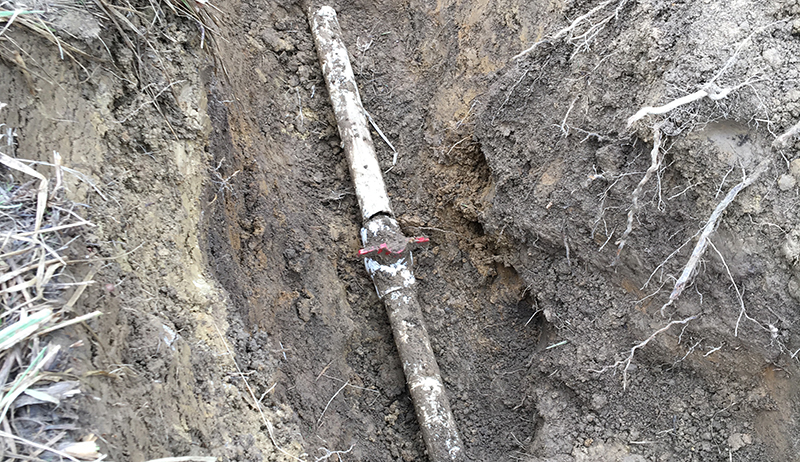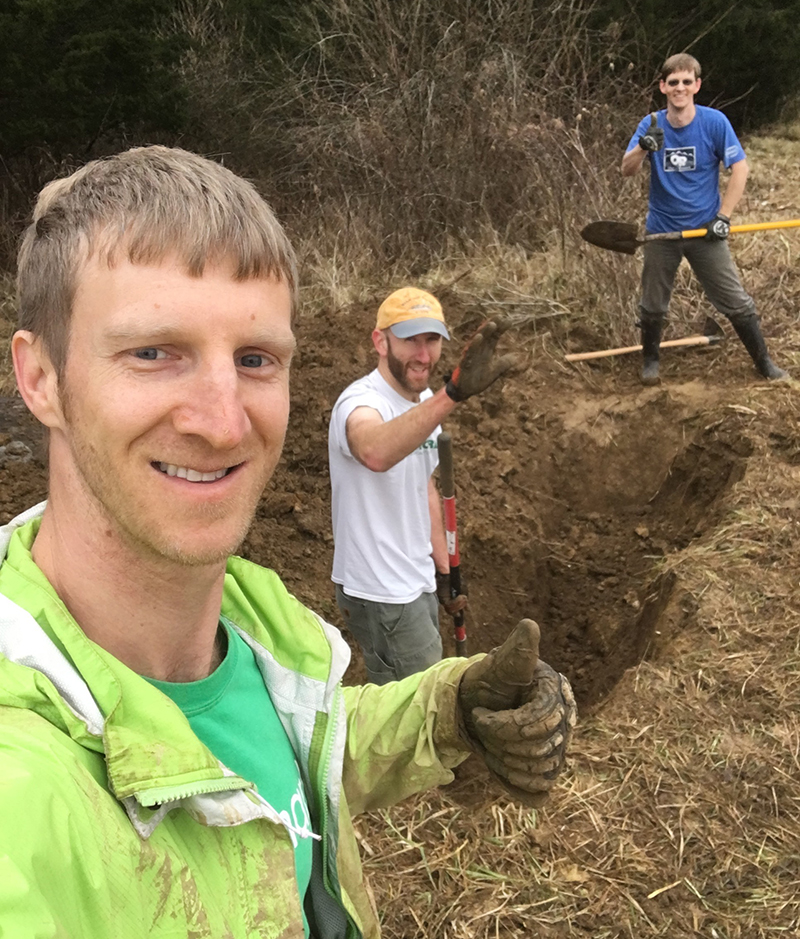
We’ve been feeling pretty good about ourselves lately. It has been a beautiful, mild February—compared to the January that nearly washed us out—and we’ve been able to accomplish a lot around the farm. On the docket this past week was to have a bush hogger come out and clear some pastures for us. All was well and good … until he got a little too close to a waterline access point. I came home from doing some work in town, turned on the faucet to wash my hands, and then nothing. Not a drip came out.
No Water: Day 1
We went out to investigate the area where the waterline is buried. We didn’t find the leak immediately, but after a half hour or so of searching, we noticed some water flowing from the top of the ridge of our Bee Hill, the area of the farm where we keep our hive. It was sprinkling a bit, but definitely not raining hard enough to form a small stream.
We followed the stream of water a short distance, and then heard something. The vertical access pipe, which sticks out of the ground 6 inches or so, was covered with a rock, and from underneath we could see the water streaming out. We found our leak!
Mr. B ran down the hill to the water meter and shutoff valve. As soon as he opened the lid, the water man showed up. He watched the meter for a minute to determine the water flow—about 30 gallons a minute—and then shut off the valve for us. This was pretty lucky timing, as we hadn’t yet learned what we needed to do to turn off the water.
Back up on the hill, we immediately started digging around the vertical access pipe so that we could see down to the waterline and investigate the problem. Unfortunately, the overly saturated soil meant that the hole we were digging quickly filled up with water. Because we couldn’t see down to the line, so the fix got put on hold until the next day.
That’s when things got complicated. That night I came down with a stomach bug—completely horrible timing. Not only was I bed-ridden and unable to help with the fix, we had no running water for a flush. Fortunately, due to the rain we had the day of the accident, our creeks were full, so we had filled up some buckets of water to have on hand for flushing. (We just didn’t imagine we’d have to flush so much … but enough about that.)
No Water: Day 2

The next day, while I was incapacitated, Mr. B and a couple dear friends—really, they are the best—continued the digging. And there was a lot of digging. They dug a trench around the pipe and were able to identify the problem area: a crack on the pipe just after the valve. It had looked like the vertical access pipe had been forced down on it—probably by the bush hog—causing the damage. By this point, it was late and we needed to purchase supplies for the repair, so we had to spend another evening waterless.
No Water: Day 3

Finally, on Day 3 of no water, we were ready to make the repair. Mr. B’s first plan was to fix the PVC with a plastic repair coupler (aka a slip coupler), but that didn’t work. It leaked when we turned the water back on. He had to cut the plastic coupler back off, which meant the hole filled up with water. Again. In order to see the work that needed to be done, he ended up scooping 50 buckets full of water out of the hole. While he’d purchased a 20-foot tube to use as a siphon in case this happened, it wasn’t quite long enough, and his hamstrings still feel the workout.
Eventually the water seepage slowed enough for him to install a metal compression coupler. This was actually a more ideal solution than the plastic coupler because it could go on the waterline wet or dry. (Thank goodness, because if it had to be dry, it would have been yet another day until we could make the full repair.)
The Silver Lining

While it wasn’t exactly the way we planned to spend our weekend, we lucked out in so many ways. Not only did we learn a lot through the process, we had the support of our kind friends and neighbors. In the end, we estimate that we saved ourselves $1,000 in emergency plumbing repairs—the DIY fix cost us only $50. Plus, we swear the water pressure is better than ever.




